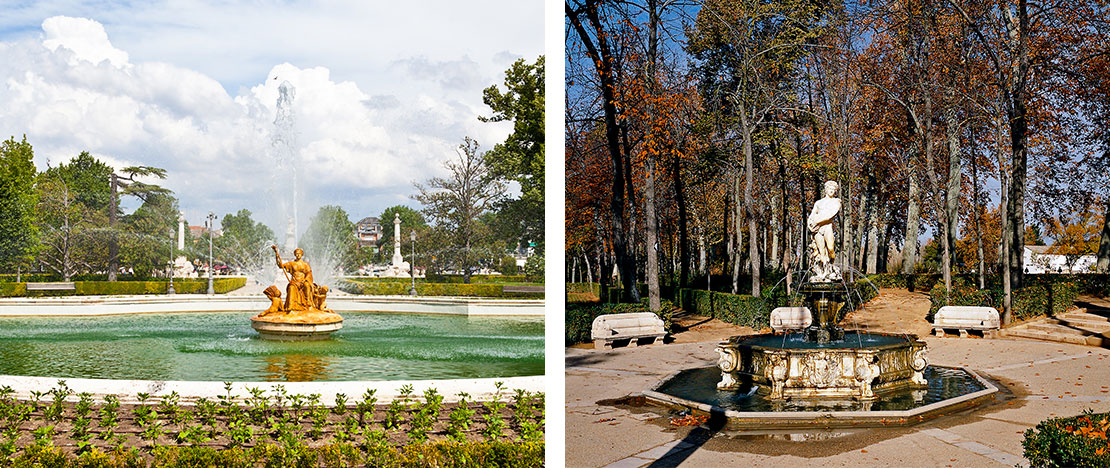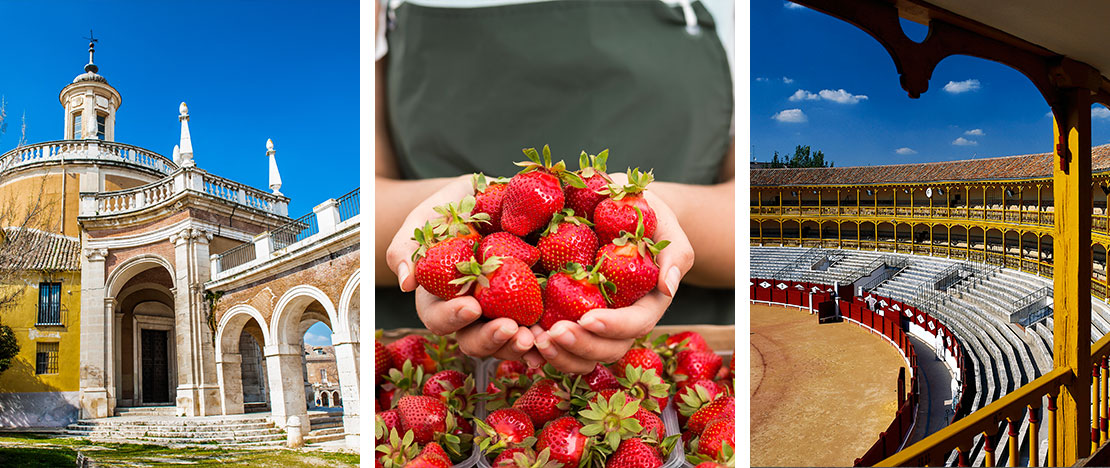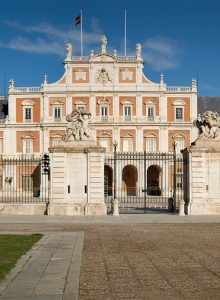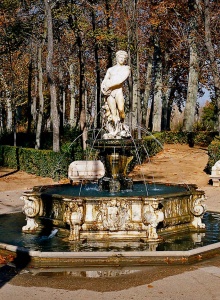MORNING
Dedicate the first part of the day to discovering the great symbol of the city, its Royal Palace and its nearby gardens, and then go for a stroll through the Aranjuez old town.
Arrival from Madrid, and a tour of the Royal Palace
If you set off early you will have more time in Aranjuez and you can tour the Royal Palace at your own pace. The easiest option is the train. The railway station is 10 minutes’ walk from the Palace. Just follow Calle de la Estación, turn left and continue along Avenida del Palacio, a pretty tree-lined road, to the palace. You will come out onto Plaza Elíptica, with a spectacular view of the building. There is also a tourist information point just there, where you can get all the information you need.
After taking a few stunning photos of the palace façade from the large parade ground, you can go inside to see why so many kings and queens of Spain chose this place for their parties and their spring residence. You can go around by yourself, or take a guided tour.
Jardín del Parterre and Jardín de la Isla. Strolling among sculptures
As you leave, head west of the Palace to the small entrance to the formal garden, the Jardín del Parterre. As soon as you go in, you’ll see a different perspective of the eastern façade of the palace, and a carefully manicured garden with mythological sculptures, including a particularly impression Hercules. Continue over the small and very charming bridge leading to the Jardín de la Isla, or island garden, surrounded by the Tagus.

This green space is larger than the last one. To your right, there is a lovely waterfall known as “the castanets” for the shape of its basins. Pause next to it to enjoy the peaceful sound of the water.As you venture further into the garden, you’ll encounter many mythological statues to remind you you’re in an almost magical place. The best way to go is along the central avenue where you can read the descriptions of the sculptures, sit in the pretty little square of the “Boy with a Thorn” to listen to the murmur of the fountains and the birds singing, and then return via the terrace with views of the river.
Historic quarter and the Bullring. Experience the national fiesta
Now it’s time for an easy walk to explore the old town centre. Go along Calle de San Antonio to the corner where it meets Calle Capitán Angosto Gómez Castrillón, a perfect spot for shopping. Behind you there is a magnificent view of a church, the Real Iglesia de San Antonio. As you continue along this street, you’ll see important buildings like the Isabel de Farnesio Cultural Centre, Medinaceli Palace, and the former Hospital de San Carlos. In this area, some of the façades conceal a surprise: the fascinating traditional corralas or tenements around a central courtyard.

In summer, you’re likely to find some of the locals selling fruit on their doorsteps (especially on Calle Eras). If not, you can always go to the Mercado de Abastos or food market to buy local strawberries or asparagus, or to Calle Almíbar for artisanal jams. A relaxed walk brings you to the 18th century bullring, one of the few surviving from that period. Although its exterior is austere, inside it offers an entertaining guided tour of the arena, the chapel, the bullpens, the alley, the stands, the barrier and an engaging Bullfighting Museum. You can take part in a mock parade and wave a cape around.
Gastronomy
After showing what you can do with a cape, back in the area around the Jardín del Parterre and all along Calle de la Reina there are plenty of places to eat, from traditional grills and inns to innovative cuisine. Some of them, such as the iconic “El Rana Verde” (opposite the Royal Palace and next to the gardens) are located alongside the river Tagus. This means you can enjoy unbeatable views and delicious local specialities like huntsman-style pheasant and locally-grown vegetables.In spring and summer you’ll also find stands around here selling strawberries. In summer, you can experience eating in the traditional Aranjuez picnic areas and terraces, which extend all along the Calle de la Reina (having dinner there is the best option, to enjoy the cooling breeze from the river). If you need a refreshment, at the beginning of Calle del Príncipe y de las Infantas there are lots of kiosks where you can savour a slush or take the chance to buy a souvenir.













